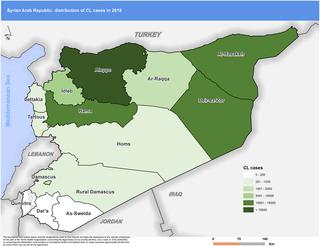当前位置:
X-MOL 学术
›
PLOS Negl. Trop. Dis.
›
论文详情
Our official English website, www.x-mol.net, welcomes your feedback! (Note: you will need to create a separate account there.)
Cutaneous leishmaniasis in Syria: A review of available data during the war years: 2011-2018.
PLOS Neglected Tropical Diseases ( IF 3.8 ) Pub Date : 2019-12-12 , DOI: 10.1371/journal.pntd.0007827 Ghada Muhjazi 1 , Albis Francesco Gabrielli 2 , José Antonio Ruiz-Postigo 2 , Hoda Atta 1 , Mona Osman 1 , Hyam Bashour 3 , Atef Al Tawil 4 , Hania Husseiny 5 , Rasmieh Allahham 5 , Richard Allan 6
PLOS Neglected Tropical Diseases ( IF 3.8 ) Pub Date : 2019-12-12 , DOI: 10.1371/journal.pntd.0007827 Ghada Muhjazi 1 , Albis Francesco Gabrielli 2 , José Antonio Ruiz-Postigo 2 , Hoda Atta 1 , Mona Osman 1 , Hyam Bashour 3 , Atef Al Tawil 4 , Hania Husseiny 5 , Rasmieh Allahham 5 , Richard Allan 6
Affiliation

|
BACKGROUND
Cutaneous leishmaniasis (CL) has historically been reported from Syria. Since 2011, the country has been affected by a war, which has impacted health and health services. Over the same period, an increase in the number of cases of CL has been reported from several areas across the country and by a number of authors. This study aims to provide the first quantitative evidence of the epidemiological evolution of CL in Syria during the war.
MATERIALS AND METHODS
Data on number of CL cases for the period 2011-2018 were extracted from three different surveillance systems: the Ministry of Health (MoH) routine surveillance system, the MoH/WHO sentinel-syndromic Early Warning Alert and Response System (EWARS), and surveillance data collected by the international nongovernmental organization (NGO) the MENTOR Initiative. Data were cleaned and merged to generate the best possible estimates on number of CL cases; incidence of CL was also calculated based on data on resident population. Data reported from the years preceding the conflict (2007-2010) were also added to the analysis for comparative purposes.
RESULTS
The analysis of data from the three available sources over the period considered indicates that number of reported cases progressively grew from prewar levels to reach a peak in 2015, decreased in 2016, remained stable in 2017, and increased again in 2018. Such a trend was mirrored by changes in incidence of infection. Some governorates, which used to report low numbers of CL cases, started recording higher number of cases after the onset of the war.
CONCLUSION
The war coincided with a major rise in reported number of CL cases and incidence of infection, although an increasing trend was already appreciable before its onset.
中文翻译:

叙利亚皮肤利什曼病:2011-2018年战时可用数据回顾。
背景技术历史上从叙利亚报道了皮肤利什曼病(CL)。自2011年以来,该国受到战争的影响,这场战争影响了卫生和保健服务。同期,全国多个地区和许多作者报告了CL病例的增加。这项研究旨在提供战争期间叙利亚CL流行病学演变的第一个定量证据。材料和方法2011-2018年间CL病例数的数据来自以下三种不同的监测系统:卫生部常规监测系统,MoH / WHO前哨综合症预警预警和响应系统(EWARS)以及由国际非政府组织(NGO)的MENTOR Initiative收集的监视数据。清理并合并数据以生成关于CL病例数的最佳估计值;CL的发生率也是根据常住人口的数据计算得出的。为了进行比较,还将冲突之前几年(2007-2010年)报告的数据添加到分析中。结果在所考虑的时期内,来自三个可用来源的数据分析表明,报告的病例数量从战前水平逐渐上升到2015年的峰值,在2016年有所下降,在2017年保持稳定,并在2018年再次上升。感染发生率的变化反映了这一点。过去曾报告过少量CL案件的一些省份,在战争爆发后开始记录更多案件。结论战争发生的同时,报告的CL病例数和感染发生率大幅上升,
更新日期:2019-12-13
中文翻译:

叙利亚皮肤利什曼病:2011-2018年战时可用数据回顾。
背景技术历史上从叙利亚报道了皮肤利什曼病(CL)。自2011年以来,该国受到战争的影响,这场战争影响了卫生和保健服务。同期,全国多个地区和许多作者报告了CL病例的增加。这项研究旨在提供战争期间叙利亚CL流行病学演变的第一个定量证据。材料和方法2011-2018年间CL病例数的数据来自以下三种不同的监测系统:卫生部常规监测系统,MoH / WHO前哨综合症预警预警和响应系统(EWARS)以及由国际非政府组织(NGO)的MENTOR Initiative收集的监视数据。清理并合并数据以生成关于CL病例数的最佳估计值;CL的发生率也是根据常住人口的数据计算得出的。为了进行比较,还将冲突之前几年(2007-2010年)报告的数据添加到分析中。结果在所考虑的时期内,来自三个可用来源的数据分析表明,报告的病例数量从战前水平逐渐上升到2015年的峰值,在2016年有所下降,在2017年保持稳定,并在2018年再次上升。感染发生率的变化反映了这一点。过去曾报告过少量CL案件的一些省份,在战争爆发后开始记录更多案件。结论战争发生的同时,报告的CL病例数和感染发生率大幅上升,

























 京公网安备 11010802027423号
京公网安备 11010802027423号